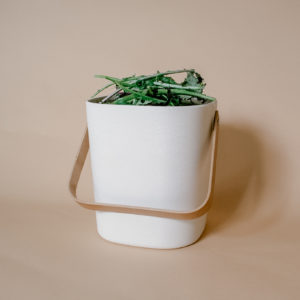The scale of the global food waste problem is huge, and in the US alone around 30-40% of the US food supply is wasted. However, there are ways that consumers can begin to make a difference by reducing the amount of organic waste that ends up in landfill. Whether that’s vegetable scraps, coffee grounds, or even food that has gone bad, the composting process offers a sustainable and circular way to minimize food waste.
While composting is low down the Food Recovery Hierarchy, and food waste can and should be avoided through better meal planning and more resourceful recipes that maximize edible produce, some level of food waste is unavoidable.
You are watching: The 10 Best Indoor Compost Bins of 2023
The good news is that you don’t need a huge garden or outdoor space to start composting. In addition to this, there is evidence suggesting that composting on your countertop can be just as, if not more efficient, with the constant temperatures helping organic matter breakdown faster (decomposition occurs between 40 and 80 degrees Fahrenheit).

Understanding Indoor Composting Bins
The first question to ask yourself before choosing an indoor compost bin is which of the three main composting methods suits your lifestyle and compost goals? Each process has its advantages, but rest assured that there is an indoor compost bin for everyone on our list.
Indoor composters generally work with these three systems:
- Vermiculture is a process by which worms consume food waste and excrete it as worm castings, which creates a nutrient rich compost.
- Aerobic composting is the traditional process of mixing green matter (food waste) and brown matter (paper, leaves etc.) and allowing the mixture to decompose.
- Anaerobic composting, of which bokashi is a variant, is composting in an airtight container with the addition of an accelerator that helps break down the waste.
Read on for indoor solutions for vermicomposting, bokashi, and traditional aerobic composting so anyone can find the best option for their kitchen.
Bokashi Starter Kit – Bokashi Living
Bokashi Living is the ideal place to start for would-be bokashi composters. This simple starter kit ships with everything you need to understand and implement this Japanese composting method.
You start by adding food waste to the bin and covering it with a sprinkle of bokashi bran each day. The bran contains microorganisms which help the food to ferment. Once the bin is full it must be sealed for two weeks. Thereafter, the contents can be buried in the garden as a pre-compost, where it combines with the soil to feed surrounding plants. The great advantage of bokashi is that it takes a wider range of food than an aerobic bin, including meat and dairy products.
Our recommendation is the company’s two-bin starter kit because while one is fermenting the other can start filling up.
SCD Probiotics Compost Bin
Read more : The Best Paints for Cabinets (24 Top Brands Blind-Tested & Reviewed)
Another dependable introduction to bokashi composting is the SCD Probiotics bin. A slightly lower budget alternative to the above, the SCD only ships with one bin so you may need to buy a second unit once you get going. Nor does it come with a warranty like the Bokashi Living option, but it does include a bag of bran and sports a spigot for draining the nutrient rich leachate which can be watered down and fed to plants. This is perhaps the least daunting investment on the list for those looking to dip a toe into bokashi composting.
Urban Composter
An interesting innovation to the bokashi method is achieved with panache in the Urban Composter. It’s a more attractive unit than the two bokashi bins above and won’t look out of place atop the kitchen counter.
The Urban Composter too creates an anaerobic environment but requires only a regular spray of their compost accelerator to boost the natural process, and you can continue to add to the bin while it’s doing its thing.
Although it doesn’t produce a ready compost, it can be buried in the garden or a plant pot for 6-8 weeks, after which it can be used as a fertilizer. This is a great low-effort compromise for those with busy urban lifestyles who still want to produce an indoor compost for houseplants from food scraps and kitchen waste.
The Worm Factory 360
The Worm Factory 360 is a true workhorse of an indoor compost bin. One of the innumerable advantages of vermiculture is that you don’t have to mix the contents of the bin yourself because the worms are creating pathways for air and moisture as they eat.
The 360 builds on this convenience by providing four stacking trays, meaning you can dismantle and empty the bin less frequently. You can add extra trays over time to suit your needs. It also comes with a five-year warranty, staking its claim as a worm bin built for longevity and targeted at those serious about vermiculture.
Urbalive Worm Farm
For those a little squeamish about the prospect of worm composting, this might be the compromise you’ve been looking for. The eminently stylish Urbalive Worm Farm will stand proudly in any modern home. And once it’s up and running, the Urbalive can handle the daily food waste from a family of four.
It consists of two layers, and after the worms have consumed the waste on the lower level, they will leave their nutrient-rich worm casts behind and move up to the higher level. There’s also a spigot on the bottom for the appetisingly-dubbed worm tea. The only drawback is the size, at 24 inches in height it’s not ideal for small spaces—but with this design why would you want to hide it?
Sacred Resources Worm Composter
What’s not to like about a sustainable compost container made with love and ready to deal with all your kitchen scraps? The Sacred Resources Worm Composter ticks all these boxes. It differs from the other vermiculture farms on the list primarily in its raw materials.
Beetle-kill pine is what is left over after the pine beetle is finished with the pine forests of Colorado. Some savvy upcycling by Sacred Resources results in one of the most beautiful products on our list. The drawback with this handcrafted compost bin is that the worm tea collects in a drip tray. It shouldn’t smell but this may be a deal breaker depending on where you want to place it.

Bamboozle Food Composter
Like any indoor aerobic countertop compost bin, the Bamboozle Food Composter is a collection container that’s designed to be emptied into a larger compost pile almost daily. With that caveat out of the way, the Bamboozle justifies its inclusion here with an iconic design and a sustainable build; it is made almost entirely from biodegradable bamboo fibre. Its charcoal filters will do a stellar job against odors for at least a few days, so if it’s a cute link in the composting chain you’re after, this is a winner.
Polder Kitchen Compost Bin
The Polder Kitchen Composter differs in two interesting ways from the standard countertop aerobic compost bin. A silicon container means it can be easily emptied or washed. It also has a rotating lid that controls the airflow and thus the rate of decomposition and strength of odor. Far from a gimmick, this is an invaluable feature for those with cramped kitchens, especially when guests are coming over.
Vitamix FoodCycler FC-50
As its premium price suggests, the Vitamix FoodCycler is a different animal. Indeed, it’s less of a composter than an organic material recycling machine. So. what exactly are you paying for? A full-cycle unit that takes everything from eggshells to bones and produces a ready-to-use fertiliser on the same day. It plugs into the mains and begins at the press of a button, dehydrating and grinding your food to a tenth of its size.
Although the FoodCycler is efficient – using less than 1kWh per cycle – it’s patently not a self-sufficient composting system. While the full picture is more complicated, the company’s claim that the product emits 54% less CO2 than an outdoor aerobic compost bin is worth noting.
For those who can’t bear vermiculture or don’t have the time to toss their compost, this is a way to reduce your food waste with minimal effort.
Envirocycle Mini Composting Bin
Though not specified as an indoor compost bin, the Envirocycle is neat and tidy enough to sit on a porch or balcony as an odor-free outdoor compost bin. It’s a simple, elegant aerobic compost bucket that will turn your food waste into black gold in as little as four weeks. Just add 25% brown material and 75% green material, turn the drum three times every three days, and drain off the leachate as you go. Just make sure you’re up to speed on what is and isn’t compostable.
The range of indoor composting options proves that any of us can take small or large steps to reduce our food waste. Ultimately, choosing an indoor compost bin comes down to your compost goals, and each has both advantages and disadvantages:
- Vermiculture is faster, more self-sustaining and yields a higher quality compost when compared to traditional processes. It can also break down meat, fish or dairy, unlike traditional compost bins. And yet the worms are not cheap and can die if not fed properly.
- Aerobic bins come in small, stylish designs but undertake a less complete process. Additionally, minimizing odors can be a challenge, and carbon filters are a must.
- Bokashi bins are the practical choice for producing usable compost quickly and efficiently, although you will need some outdoor space to let the fermented food waste sit for two weeks.
Finally, even if you don’t have a garden or space on your kitchen, you can still finding a nearby compost disposal site to ensure you are doing your part to reduce what ends up in landfill.
Remember, indoor composting is only one path toward reducing food waste. For more resources to help you cut your food waste at home or at work, subscribe to the blog or browse the store today.
Contact one of our TRUE Advisors today.
Source: https://gardencourte.com
Categories: Kitchens

